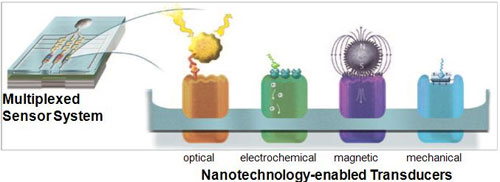
The NSI coordinates existing and emerging efforts to explore the use of nanotechnology in two thrust areas:
1. Develop and promote adoption of new technologies that employ nanoscale materials and features and the size dependent properties of engineered nanomaterials to overcome technical barriers associated with conventional sensors, focusing on three goals;
- Support research on nanomaterials and nanoscale device components to enable the next generation of sensors, including tunable, label-free, and enzymatic sensors
- Support development of integrated and portable sensor devices, including information systems support for collection, analysis, and transfer of large amounts of sensor data
- Accelerate commercialization and expand the application base of existing nanosensor base
2. Develop methods and devices to detect and identify engineered nanomaterials across their life-cycles in order to assess their potential impact on health, safety, and the environment, focusing on three goals:
- Identify and quantify unique magnetic, optical and electronic signatures of nanomaterials in specific matrices with minimal sample preparation
- Identify “surrogate” indicators of nanomaterial presence
- Design and develop “tags” for nanomaterials that will enable their detection and measurement if released into the environment
Further reading the details of the initiative, several aspects that are relevant to the nanomanufacturing community include the implementation of successful nanomanufacturing processes, which will be further coordinated through the NSI on Sustainable Nanomanufacturing. The NSI will further establish protocols and standards for device testing, data collection, transfer and assessment, and establish open-format databases on nanomaterials. The second thrust will address challenges in developing sensors and tools to characterize the physical and chemical properties of nanomaterials, and understand these emergent properties in the context of physical and biological environments, thereby coordinating with the NSI on Nanotechnology Knowledge Infrastructure and the NNI Environmental, Health, and Safety Research Strategy. Such a coordinated initiative provides the infrastructural emphasis that has been lacking in the micro/nanosensor world to date. Many commercialization strategies have been premature, and doomed to failure for diverse reasons including lack of consistent materials supply chain, lack of scaled manufacturing processes, or inadequate levels of integration for built in redundancy, data acquisition, and signal processing which all enable low-cost integrated system designs to be commercially competitive. By attacking the problem from all aspects in a concerted fashion, the level of successful deployment and commercialization of nanosensors, as well as nano-enabled sensor systems will improve substantially. In this context, the concept of nanosensor systems monitoring nanomaterials now seems within reach, and still rather intriguing.
